A well-designed plumbing layout is crucial for ensuring a safe, efficient, and cost-effective plumbing system in any building. A good plumbing layout can help reduce water consumption, minimize pipe installation costs, and prevent potential plumbing issues. In this article, we’ll explore some valuable tips for designing an efficient plumbing layout.
Key Considerations for Plumbing Layout Design
1. Water Flow Rate: Determine the required water flow rate for each fixture and appliance to ensure the plumbing system can meet demand.
2. Pipe Sizing: Choose the right pipe size to minimize pressure drop, reduce noise, and prevent water hammer.
3. Layout and Configuration: Design the layout to minimize pipe runs, reduce bends, and avoid unnecessary fittings.
4. Drainage and Venting: Ensure proper drainage and venting to prevent siphoning, backflow, and odor issues.
5. Accessibility and Maintenance: Design the system for easy access and maintenance to reduce repair costs and downtime.
Tips for Designing an Efficient Plumbing Layout
1. Group Fixtures Together: Grouping fixtures like sinks, toilets, and showers can reduce pipe runs and installation costs.
2. Use a Central Water Distribution Point: A central water distribution point can simplify the plumbing layout and reduce pipe lengths.
3. Minimize Pipe Bends and Fittings: Minimize pipe bends and fittings to reduce pressure drop, noise, and potential leak points.
4. Use Proper Pipe Sizing: Choose the right pipe size for each section of the plumbing system to ensure adequate water flow and pressure.
5. Consider Future Needs: Design the plumbing system with future needs in mind, including potential additions or renovations.
6. Label and Document the System: Label and document the plumbing system to facilitate future maintenance and repairs.
Benefits of an Efficient Plumbing Layout
1. Water Conservation: An efficient plumbing layout can help reduce water consumption and lower utility bills.
2. Cost Savings: A well-designed plumbing layout can reduce installation costs, minimize repairs, and lower maintenance costs.
3. Improved Performance: An efficient plumbing layout can ensure consistent water pressure, reduce noise, and prevent plumbing issues.
4. Increased Property Value: A modern, efficient plumbing system can increase property value and appeal to potential buyers.
Conclusion
Designing an efficient plumbing layout requires careful consideration of several factors, including water flow rate, pipe sizing, layout, and drainage. By following these tips and considering future needs, you can create a plumbing system that is safe, efficient, and cost-effective.

